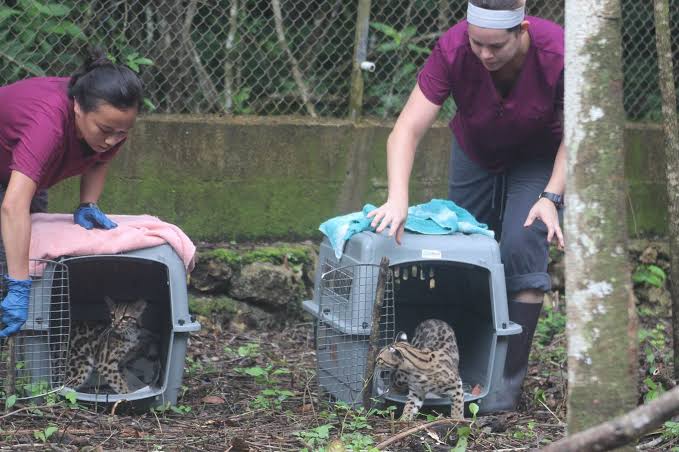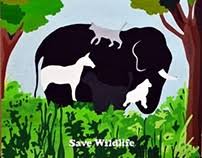All you need to know about Saving the Wild Life
Saving wild life is important to maintaining the balance of our planet’s ecosystems. Wildlife conservation involves protecting species and their habitats, as well as reducing the negative impact of human activity on their environment. Here are some ways to help save wild life:
Support Conservation Organizations: There are many organizations that work to protect wildlife and their habitats. You can support them by donating money, volunteering, or spreading awareness of their efforts.
Reduce Plastic Use: Plastic waste is a major threat to wildlife. Reduce your plastic use by bringing reusable bags, water bottles, and containers.
Don’t Buy Products Made from Endangered Species: Many products are made from endangered species, such as ivory or shark fins. Avoid buying these products and support sustainable alternatives instead.
Reduce Your Carbon Footprint: Climate change is also a threat to wildlife. You can reduce your carbon footprint by driving less, using energy-efficient appliances, and supporting renewable energy.
Support Sustainable Agriculture: Habitat loss is a major threat to wildlife. You can support sustainable agriculture practices that preserve and restore natural habitats.
Educate Others: Spread awareness of the importance of wildlife conservation and how individuals can make a difference.
Avoid Supporting Captivity: Many wild animals are captured and kept in captivity for entertainment or as pets. Avoid supporting these practices and encourage others to do the same.
By taking these steps, we can all contribute to saving wild life and ensuring that our planet’s ecosystems remain healthy and thriving.
Read Also: How to Make Neem Insecticide from Neem Leaves (Dogoyaro)
Importance of Saving Wild Life

Saving wildlife is crucial for several reasons:
Biodiversity: Wildlife is an important part of our planet’s biodiversity, which is essential for maintaining healthy ecosystems. Every species, no matter how small, plays a role in maintaining the balance of the ecosystem.
Ecological balance: Wildlife helps maintain ecological balance by pollinating plants, controlling pests, and regulating the food chain. When a species is lost, it can have a ripple effect on the entire ecosystem.
Scientific research: Many species of wildlife are used for scientific research, which helps us understand how the natural world works and how we can better protect it.
Cultural importance: Wildlife has cultural and spiritual significance for many people around the world. It is important to preserve these cultural connections to nature.
Economic value: Wildlife tourism, hunting, and fishing can provide economic benefits to local communities. By preserving wildlife and their habitats, we can help support sustainable economic development.
Climate change: Wildlife plays an important role in mitigating the effects of climate change. For example, forests help absorb carbon dioxide from the atmosphere, which helps reduce greenhouse gas emissions.
However , saving wildlife is important for the health and well-being of our planet and its inhabitants. By protecting wildlife and their habitats, we can ensure a sustainable future for ourselves and future generations.
Climate Change and WildLife
Habitat loss: As temperatures rise, many wildlife habitats are becoming unsuitable for the species that rely on them. This can result in habitat loss and fragmentation, which can reduce the availability of food, shelter, and breeding grounds for wildlife.
Changes in behavior: Climate change is also causing changes in the behavior of wildlife. For example, some bird species are nesting earlier in the year due to changes in temperature and precipitation patterns.
Range shifts: Some species are also shifting their ranges as a result of climate change. For example, some fish species are moving to cooler waters as ocean temperatures rise.
Extinctions: Climate change is also increasing the risk of extinction for many species. Some species may not be able to adapt quickly enough to the changing climate, which can result in population declines and, in some cases, extinction.
Invasive species: As habitats change, invasive species may move into new areas and compete with native species for resources.
Disease: Climate change is also increasing the spread of diseases among wildlife populations. For example, warming temperatures are allowing disease-carrying insects to expand their ranges.
Efforts to address climate change are essential to protecting wildlife and their habitats. This includes reducing greenhouse gas emissions, promoting renewable energy, and supporting adaptation strategies for wildlife populations that are already experiencing the impacts of climate change.
Read Also: Importance of Agriculture and the Way Forward
Save Wild Animals

Protect habitats: The first step in saving wild animals is to protect their habitats. This means preserving natural areas, such as forests, wetlands, and grasslands, and preventing their destruction through activities like deforestation, mining, and urbanization.
Combat poaching: Poaching is a major threat to many species of wild animals, particularly those that are hunted for their ivory, fur, or other body parts. Governments and conservation organizations can work to combat poaching by enforcing laws against illegal hunting and trafficking, as well as by educating people about the negative impacts of poaching on wild animal populations.
Promote sustainable practices: Encouraging sustainable practices, such as sustainable agriculture and forestry, can help to protect wild animals by reducing habitat destruction and fragmentation.
Support conservation organizations: There are many organizations dedicated to saving wild animals, such as the World Wildlife Fund, the Wildlife Conservation Society, and the International Union for Conservation of Nature. Supporting these organizations through donations or volunteering can help to fund conservation efforts and raise awareness about the importance of saving wild animals.
Reduce human-wildlife conflict: As human populations expand, there is an increasing risk of conflict between humans and wild animals. This can lead to the destruction of habitats and the killing of wild animals. Strategies such as building wildlife corridors, using non-lethal methods to deter wild animals from human settlements, and promoting coexistence between humans and wild animals can help to reduce this conflict.
Educate others: Educating others about the importance of saving wild animals is crucial to promoting conservation efforts. This can include teaching children about the value of biodiversity and the need to protect habitats, as well as raising awareness through social media, events, and other channels.
In summary, saving wild animals requires a multifaceted approach that involves protecting habitats, combatting poaching, promoting sustainable practices, supporting conservation organizations, reducing human-wildlife conflict, and educating others about the importance of conservation. By working together, we can help to ensure that wild animals are able to thrive and that future generations are able to enjoy the diversity of life on our planet.
Read Also: Cassava (Manihot esculenta)









